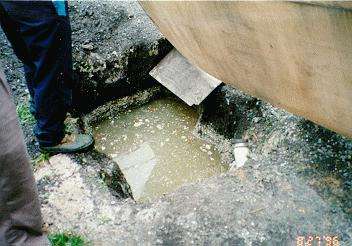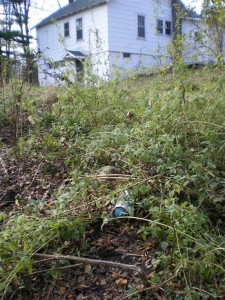Regulations have been made, legislation passed and enforcement tightened. Yet leaking septic tanks continue to threaten human and environmental health.

Effluent above the septic tank, an indication of a failed absorption field or a crushed or clogged effluent line. Image: Virginia Department of Health
The rules are well-intended, said Sandra Shaefer, a septic tank coordinator for Minnesota’s Dodge County. But the failing conditions of many septic systems make them hard to administer.
Coming up with funds to fix the problems is an increasing challenge for health officials battling the pollution that comes from the failing systems that serve homes without sewers. Several local governmental in Great Lakes states are rising to the challenge.
Several years ago, the Dodge County required failing systems to be upgraded prior to the sale of a house, Shaefer said.
“We hoped to arrest the problem at that point when we were sure there was money exchanging hands,” she said.
But county officials realized that few people had the money to make costly repairs and that septic pollution would continue even under tight surveillance.
In 2009, Shaefer’s team administered grants to assist low-income homeowners in upgrading septic systems discharging waste to the ground and surface water.
The money comes from the Clean Water, Land and Legacy Amendment, a state program that seeks to protect land, forests and water sources.
Last year, the grant assisted four homeowners and more assistance is expected this year.
Contamination from faulty septic systems has been a long-standing problem in the county mainly because the region has a thin layer of soil — less than two feet between the drainfield and the water table — making underground water at risk of pollution, Shaefer said.
Walworth County – Wisconsin
In Wisconsin, nearly all counties participate in a similar program that is but federally funded. Walworth County which has been a participant since 1982 and has assisted close to 500 homeowners in repairing or install new systems, said Rick Dorgay, the county’s enforcement officer for sanitation.
The program funds a portion of the cost of upgrading systems that are leaking wastewater to the ground and surface waters and bedrock. Those backing up waste to homes aren’t funded.
Applicants must earn less than $45,000 a year and occupy their property more than half the year.
The county has seven large and popular lakes, and policies to ensure that they stay clean and healthy, said Dorgay.
“A lot of systems around the lake don’t have pollution problems because properties around the lake are mandated to be in a maintenance program enforced by the county,” he said.
The program requires all the 16,000 to 17,000 septic systems around the lakes to be pumped out or inspected at least once every two years.
“It’s like maintaining a car,” Dorgay said. “If you don’t check and change your oil regularly, your engine will fail.”
Bay County, Michigan

Home with no septic system..just a pipe discharging sewage to the ground surface. Image: Barry-Eaton District Health Department (Michigan)
In Michigan, Bay County recently started a revolving loan fund for homeowners with faulty septic tanks.
“It’s a very low-interest loan and a lot of times people will not have to pay on it until they are selling or refinancing their homes,” said Joel Strasz, the county’s public health manager.
The new program has received seed funding of close to $100,000 from the Saginaw Bay Watershed Initiative Network, Bay Area Community Foundation and most recently from the Dow/PIRGIM Settlement.
County officials have applied for more federal funding from the Great Lakes Regional Initiative Fund, said Laura Ogar, Director of Bay County Environmental Affairs and Community Development.
Though the county had previously enforced its sanitary code that requires a failing septic system to be repaired or replaced in a timely manner, officials realized that wasn’t solving the problem.
“A lot of times people get a bill of $8,000 from septic tank installers and they just don’t know what to do,” he said.
Replacing a septic tank ranges between $5,000 and $10,000, but could go higher, Strasz said.
“We definitely have had problems of bacteria in Kawkawlin River and the coastal areas and this is just one way of dealing with the reality of the situation,” he said.
The county also has lots of older housing with pipes leading to ditches or just ending “somewhere”, he said. Many times people living in such homes don’t know where their tanks are located or how they are working.
In the last four to five years, the county has experienced elevated bacteria counts in its lakes, Strasz said. Septic wastewater and agriculture runoffs are suspected but the county hasn’t determined the culprit.
This loan system will only benefit owners of septic systems adjacent to the surface waters, Ogar said.
“This is a real practical step to help reduce pollution in Saginaw River and other rivers around us,” Ogar said. “If people can’t afford repairs, we in Bay County feel the responsibility to step in and provide solutions.”
*Updated Monday, June 28 at 10:53 a.m. to fix spelling of Laura Ogar
 SEPTIC SETBACKS
SEPTIC SETBACKS
This special report examines how ill maintained, leaky and overflowing septic tanks are polluting drinking water sources and causing serious health concerns in Great Lakes communities.
Mary is on the right track but you do not need the USDA.
The trick is to aggregate participation to a prudent economy of scale and share the cost. Typically economies of scale can be optimized between 3 and 25 homes depending on the level of treatment that is required. It could be paid for by imposing a betterment through the health authority securing it with the property because the betterment is senior to the mortgage. If local health authorities and communities would provide for this under the sewer ordinances you would effectively have distributed sewer. With this 3 things happen. You achieve economies of scale, you remove the homes from the imposed property restrictions under the health codes and you get the system under some form of professional management.
In one form or another this has been done.
I have talked to banks about this and they have considered it a viable financial instrument that could be pooled an sold into secondary markets. Contact me at chlindell@aquapoint.com
Who has the money to sewer the world. Sewers break down too. There are many new technologies that can upgrade septics right at the source, don’t involve a lot of expensive pipe or pumps, and they are cost-effective too.
On behalf of the protectors of water quality, compliments to the proactive townships, counties, and health departments who adopt ordinances requiring an evaluation of septic systems at the time of title transfer.
The key to sepitic problems is simple – get rid of them and install appropirate wastewater treatment systems and sewers. Not always an option in far-flug agricultural areas but in lake/river communities, it should be mandatory. Checkout USDA Rural Development for possible funding options.